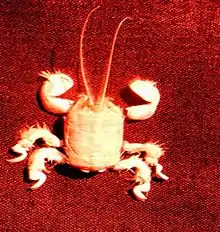Albunea carabus
Albunea carabus is a rare species of "sand crab" or "mole crab" in the genus Albunea. It lives in shallow, turbulent waters in sandy areas of the tropical eastern Atlantic Ocean and the Mediterranean Sea.
| Albunea carabus | |
|---|---|
 | |
| Scientific classification | |
| Kingdom: | |
| Phylum: | |
| Subphylum: | |
| Class: | |
| Order: | |
| Family: | |
| Genus: | |
| Species: | A. carabus |
| Binomial name | |
| Albunea carabus | |
| Synonyms [1] | |
| |
Description
Albunea carabus is typically up to 2 centimetres (0.8 in) long. In common with other species of Albunea,[2] it has a quadrangular carapace with a concave rear edge, and flattened legs, which it uses for digging in sand.[3] The first pair of pereiopods are subchelate (forming a claw with one movable finger pressing onto a solid edge, rather than a fixed finger), and all five pairs are flattened into shovels and are effective at digging.[4] The pleon (abdomen) is shorter than the carapace, and bears four pairs of pleopods in females, but none in males. The pleon ends in a telson flanked by a pair of uropods, which are similar in form to the pereiopods, and aid in digging.[4]
The larvae of Albunea carabus are likely to pass through five planktonic zoea instars before reaching the juvenile stage, as also seen in Albunea symmysta. Over the first three of these instars, the larvae increase from around 1.56 mm to around 2.72 mm in total length.[5] By the third zoea instar, the pereiopods begin to show as small buds, and uropods are present alongside the broad telson.[5]
Distribution
Albunea carabus is found on parts the African coast of the Atlantic Ocean and in the Mediterranean Sea, where it is the only mole crab.[6] It is widespread in the western Mediterranean basin (Ligurian Sea and Tyrrhenian Sea), but is only known from very few records east of the Straits of Messina. These have included a site off the estuary of the Nahr Rubin river in Israel,[6] and several collections from the Gulf of İskenderun.[7] Albunea carabus has also been recorded from Ghana, Togo and Benin,[8] but records from Saint Helena, the Azores and Madeira could refer to the related species A. paretii.[9]
Ecology
Albunea carabus typically lives slightly offshore, at depths of 3–40 m (10–131 ft),[6] in sandy environments where the water is very turbid.[10] It seems to prefer areas with strong hydrodynamics, including estuaries.[9]
Taxonomy
Albunea carabus was first described by Carl Linnaeus in his 1758 10th edition of Systema Naturae, as "Cancer carabus". He had received the material from Erik Skjöldebrand ("E. Brander"), the Swedish consul in Algiers.[6] Friedrich Weber erected the new genus Albunea in 1795 for this species and Albunea symmysta.[1] Within the genus Albunea, Albunea carabus is placed in the informal "A. carabus group" of species, alongside A. bulla and A. danai.[8] The group also includes two fossil species – A. asymmetrica and A. turritellacola.[11]
Antoine Risso described "Hippa caerulea" as a new species in 1816; although this was synonymised with A. carabus by Lipke Holthuis in 1977 (with reservations), it is now thought to be an isopod of the genus Gnathia, perhaps Gnathia phallonajopsis.[2]
References
- Michael Türkay (2012). "Albunea carabus (Linnaeus, 1758)". WoRMS. World Register of Marine Species. Retrieved November 12, 2012.
- Christopher B. Boyko (2001). "The identity of Hippa caerulea Risso, 1816: an isopod in mole crab's disguise". Crustaceana. 74 (1): 115–122. doi:10.1163/156854001505299. JSTOR 20106417.
- Giovanni Nikiforos (2008). Fauna del Mediterraneo. Giunti Editore. p. 150. ISBN 9788809026087.
- Ricardo Zariquiey Alvarez (1961). "Decápodos españoles XV. Sobre un raro Crustáceo decápodo: Albunea carabus (L., 1758)" (PDF). Investigación Pesquera. 19: 103–110.
- R. Seridji (1988). "Some planktonic larval stages of Albunea carabus (L., 1758) (Crustacea, Decapoda, Anomura)". Journal of Natural History. 22 (5): 1293–1300. doi:10.1080/00222938800770791.
- Tuncer Katağan and Cem Çevik (2003). "A new record of Albunea carabus (L., 1758) (Decapoda, Anomura, Hippidea) from the Eastern Mediterranean Coast of Turkey". Crustaceana. 76 (5): 637–639. doi:10.1163/156854003322316272. JSTOR 20105602.
- Cengiz Koçak, Tuncer Katağan & Tahir Ozcan (2005). "Anomura of the Iskenderun Bay Region (Southeastern Turkey)". Crustaceana. 78 (2): 247–252. doi:10.1163/1568540054020578. JSTOR 20107478.
- Christopher B. Boyko (2002). "A worldwide revision of the recent and fossil sand crabs of the Albuneidae Stimpson and Blepharipodidae, new family (Crustacea: Decapoda: Anomura: Hippoidea)" (PDF). Bulletin of the American Museum of Natural History. 272: 1–396. doi:10.1206/0003-0090(2002)272<0001:AWROTR>2.0.CO;2. hdl:2246/436.
- S. Giacobbe & N. Spanò (1996). "New records of Albunea carabus (L., 1758) (Decapoda, Anomura) in the Mediterranean Sea". Crustaceana. 69 (6): 719–726. doi:10.1163/156854096X00736. JSTOR 20088743.
- N. Spanò, P. Rinelli & S. Ragonese (1999). "The first find of Albunea carabus (Decapoda, Anomura) on the southern Sicilian coasts (Strait of Sicily, Mediterranean Sea)". In Frederick R. Schram & J. Carel von Vaupel Klein (ed.). The Biodiversity Crisis and Crustacea: Proceedings of the Fourth International Crustacean Congress, Amsterdam, the Netherlands, July 20–24, 1998. Crustacean issues. 12. Brill Publishers. pp. 617–622. ISBN 978-90-04-11387-9.
- René H. B. Fraaije, Barry W. M. van Bakel & John W. M. Jagt (2008). "Albunea turritellacola, a new sand crab (Anomura, Albuneidae) from the lower Miocene of southwest France" (PDF). Bulletin of the Mizunami Fossil Museum. 34: 1722.